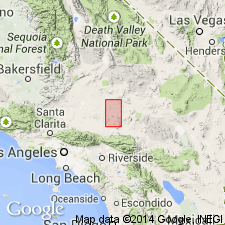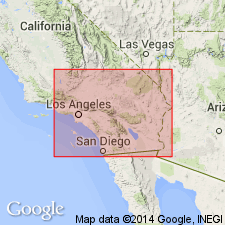
- Usage in publication:
-
- Hinkley Valley complex
- Modifications:
-
- Original reference
- Dominant lithology:
-
- Limestone
- Quartzite
- Schist
- Igneous material
- AAPG geologic province:
-
- Mojave basin
Summary:
Pg. 77-79. Hinkley Valley complex. Consists largely of metasediments, mostly crystalline limestone, together with some quartzites and schists; igneous material subordinate. Contact with Hodge complex not distinct, differentiation made on basis of igneous material present. Considered oldest known rocks in Barstow and Victorville map areas. Paleozoic or older with early Precambrian most probable.
Named from outcrops in and around Hinkley Valley, Rarstow quadrangle, southern CA. Not recognized in Victorville area.
Source: US geologic names lexicon (USGS Bull. 1200, p. 1768).

- Usage in publication:
-
- Hinkley Valley complex
- Modifications:
-
- Age modified
- AAPG geologic province:
-
- Mojave basin
Summary:
Pg. 503-504. Faunal evidence indicates age may be wholly Paleozoic.
Source: US geologic names lexicon (USGS Bull. 1200, p. 1768).
For more information, please contact Nancy Stamm, Geologic Names Committee Secretary.
Asterisk (*) indicates published by U.S. Geological Survey authors.
"No current usage" (†) implies that a name has been abandoned or has fallen into disuse. Former usage and, if known, replacement name given in parentheses ( ).
Slash (/) indicates name conflicts with nomenclatural guidelines (CSN, 1933; ACSN, 1961, 1970; NACSN, 1983, 2005, 2021). May be explained within brackets ([ ]).

